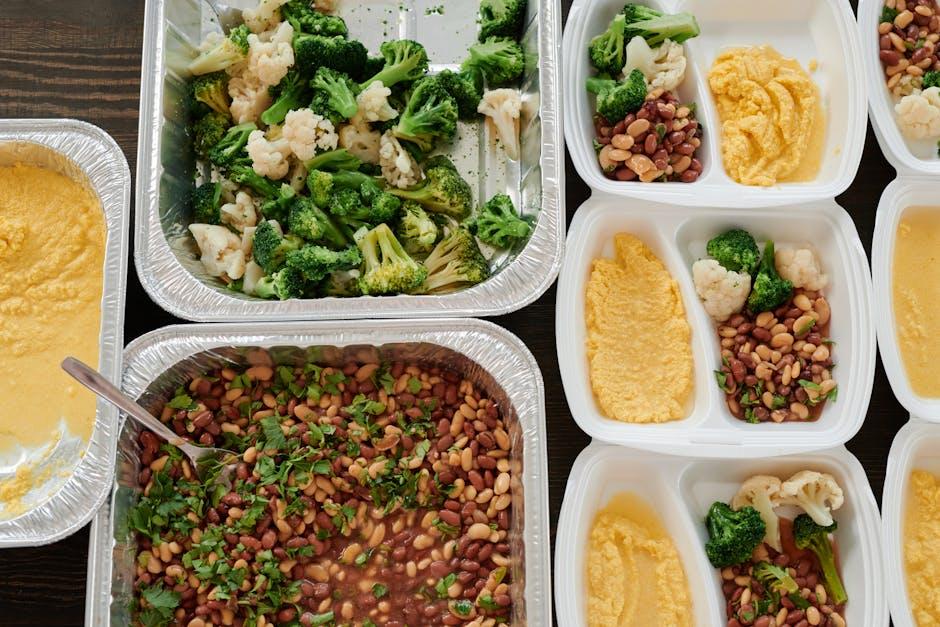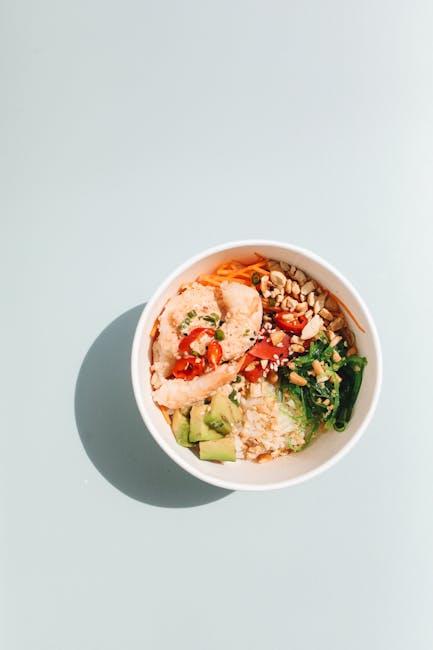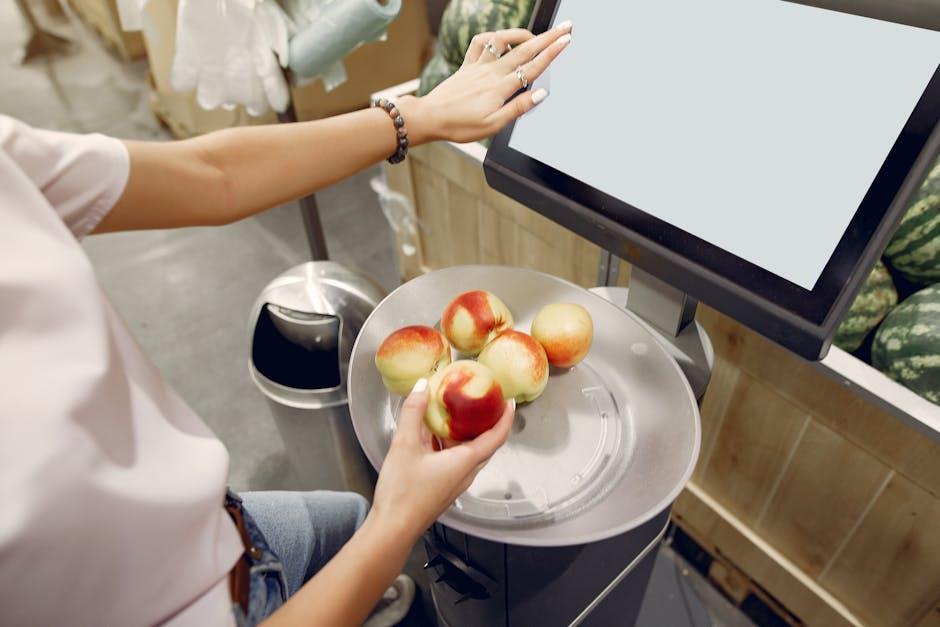Embarking on the journey of meal planning can feel like navigating a maze without a map—exciting yet overwhelming. For beginners, the idea of organizing weekly meals might seem daunting, but it holds the key to transforming chaotic mealtimes into moments of calm and control. Whether you’re looking to save time, reduce stress, or embrace healthier eating habits, mastering the basics of meal planning can be a game-changer. In this article, we’ll explore practical and approachable tips to help you build a meal planning routine that fits your lifestyle, making your kitchen a place of creativity and nourishment rather than last-minute scrambles.
Table of Contents
- Understanding Your Dietary Needs and Preferences
- Building a Balanced and Flexible Meal Framework
- Smart Grocery Shopping Strategies to Save Time and Money
- Simple Meal Prep Techniques for Busy Schedules
- Staying Motivated and Adjusting Your Plan Over Time
- Q&A
- Closing Remarks

Understanding Your Dietary Needs and Preferences
Every successful meal plan starts with a clear understanding of what your body needs and what you actually enjoy eating. Tailoring your meals to fit both nutritional requirements and personal tastes ensures you stick to your plan without feeling deprived. Consider your activity level, any dietary restrictions, and specific health goals—be it weight management, muscle gain, or simply maintaining good health. Recognizing these factors helps you select foods that fuel your body effectively while keeping mealtime exciting and satisfying.
It’s also important to acknowledge your unique preferences, which can include flavors, textures, and cultural influences. Incorporating foods you love encourages consistency and eliminates the temptation to stray from your plan. Start by jotting down your favorite ingredients and types of dishes, then prioritize those in your weekly menu. Here’s a quick checklist to get started:
- Identify dietary restrictions: allergies, intolerances, or medical conditions
- Balance macronutrients: proteins, fats, and carbohydrates
- Choose whole, minimally processed foods: fresh fruits, vegetables, and grains
- Maintain variety: prevents boredom and ensures a range of nutrients
| Diet Type | Example Foods | Key Benefit |
|---|---|---|
| Vegetarian | Legumes, tofu, quinoa, vegetables | Rich in fiber and antioxidants |
| Low Carb | Fish, eggs, green veggies, nuts | Supports blood sugar control |
| Gluten-Free | Rice, corn, fruits, lean meats | Prevents digestive discomfort |

Building a Balanced and Flexible Meal Framework
Creating a meal framework that balances nutrition while remaining adaptable is key to long-term success. Start by identifying core food groups that satisfy your dietary needs and preferences, such as lean proteins, whole grains, healthy fats, and vibrant vegetables. Use colors and textures to make meals visually appealing, which encourages mindful eating. Don’t be afraid to mix and match ingredients—this prevents monotony and keeps your taste buds intrigued. Incorporate flexibility by allowing occasional indulgences or swaps, ensuring your plan feels sustainable rather than restrictive.
To simplify your efforts, consider this easy reference table outlining ideal portion sizes for each food group within one meal:
| Food Group | Portion Size | Examples |
|---|---|---|
| Proteins | 3-4 oz | Chicken, tofu, fish |
| Vegetables | 1-2 cups | Spinach, carrots, broccoli |
| Whole Grains | ½ cup cooked | Quinoa, brown rice, oats |
| Healthy Fats | 1-2 tbsp | Olive oil, avocado, nuts |
- Plan for variety: Rotate different protein sources and vegetables each week.
- Prep ahead: Batch cooking and portioning meals save time and reduce decision fatigue.
- Listen to your body: Adjust portions and ingredients according to your hunger and energy levels.

Smart Grocery Shopping Strategies to Save Time and Money
Shopping smartly not only conserves your budget but also carves out more precious minutes in your busy day. Before stepping into the store, draft a well-organized list categorized by sections—produce, dairy, pantry staples—and stick to it religiously to avoid impulse buys. Utilizing apps or digital coupons can amplify savings while helping you track price drops and personalized deals. When selecting brands, consider quality and cost-effectiveness; sometimes, store brands offer identical quality at a fraction of the price.
Time-saving techniques are equally essential:
- Opt for stores that provide online ordering with curbside pickup or delivery.
- Shop during off-peak hours to breeze through aisles without hassle.
- Prepare staple ingredients in bulk ahead of time, such as chopping veggies or pre-cooking grains, reducing the burden during rushed evenings.
| Smart Choice | Benefit |
|---|---|
| Seasonal Produce | Lower cost & fresher taste |
| Bulk Buying Staples | Save money & reduce trips |
| Generic Brands | Comparable quality, less expense |

Simple Meal Prep Techniques for Busy Schedules
When time is limited, focusing on a few key techniques can transform your weekly meals from chaotic to calm. Start by choosing versatile ingredients that can be easily mixed and matched throughout the week, such as grilled chicken, roasted vegetables, and grains like quinoa or rice. Preparing these in bulk and storing them in clear, compartmentalized containers not only saves time but also promotes balanced eating. Incorporating simple seasoning blends and sauces ahead of time can instantly elevate basic dishes without adding complexity to your daily routine.
Efficiency is essential for meal prep success, so consider setting aside a specific time each week dedicated solely to cooking. During this session, focus on multi-tasking smartly: roast vegetables while quinoa cooks, and chop fresh greens for salads to ensure freshness throughout the week. Below is a simple table that outlines a practical prep schedule you can adapt:
| Task | Duration | Tips |
|---|---|---|
| Cook proteins (chicken, tofu) | 30 min | Use oven or slow cooker to save active time |
| Prepare grains | 20 min | Cook in bulk; freeze portions if needed |
| Chop veggies | 15 min | Store in airtight containers with paper towels for freshness |
| Assemble sauces/dressings | 10 min | Keep in small jars; great for customizing meals |
- Choose simplicity: Simple recipes with fewer ingredients speed up prep and reduce waste.
- Invest in quality containers: Leak-proof and microwave-safe options make reheating effortless.
- Rotate menus: Keep meals interesting by cycling through different flavors weekly.

Staying Motivated and Adjusting Your Plan Over Time
Keeping your enthusiasm alive is essential as you embark on your meal planning journey. Motivation often fluctuates, so embracing flexibility can make the process feel less like a chore and more like a lifestyle choice. Celebrate small victories—whether it’s trying a new recipe or successfully prepping snacks for the week—and remind yourself why you started. Incorporate variety by swapping out ingredients or exploring different cuisines to keep your meals exciting. Also, consider connecting with friends or online communities for shared inspiration and accountability.
As life changes, so should your meal plan. Regularly assess what’s working and where you might need tweaks. Use the table below to track your satisfaction and identify adjustments easily:
| Aspect | Current Status | Possible Adjustment |
|---|---|---|
| Meal Prep Time | Too lengthy | Batch cook staples |
| Variety | Repetitive meals | Try new recipes weekly |
| Budget | Over plan | Use seasonal produce |
| Enjoyment | Some meals bland | Add herbs & spices |
- Stay open: Modify portion sizes or meal times as your schedule changes.
- Be kind to yourself: Skipped days are normal—refocus without guilt.
- Keep goals dynamic: Adjust your nutritional targets as your health needs evolve.
Q&A
Q&A: Meal Planning Tips for Beginners
Q1: What is meal planning, and why should beginners consider it?
A: Meal planning is the practice of organizing your meals in advance, usually for a week or more. For beginners, it’s a powerful way to save time, reduce stress, cut down food waste, and maintain a balanced diet. Thinking ahead transforms the daily “What’s for dinner?” dilemma into a smooth, creative routine.
Q2: How can a beginner start with meal planning without feeling overwhelmed?
A: Start small. Choose one or two days a week to plan meals first. Use simple recipes with readily available ingredients. Gradually build variety as you gain confidence. Remember, meal planning is a flexible tool, not a strict rulebook.
Q3: Are there any tools or apps that can help with meal planning?
A: Absolutely! From digital calendars and grocery list apps to specialized meal planning tools like Paprika, Mealime, or Plan to Eat, there are many resources. They can suggest recipes, help organize shopping lists, and even track your pantry inventory.
Q4: How important is balancing nutrition in meal planning?
A: Very important. Beginners should aim to include a good mix of proteins, vegetables, whole grains, and healthy fats. Planning meals with nutritional balance in mind fosters better health and sustained energy throughout the day.
Q5: What if I don’t like sticking to the same meals every week?
A: That’s normal! Variety keeps things interesting. Rotate recipes, try new cuisines, and incorporate seasonal produce. Batch-cooking and freezing portions can also help by giving you quick options to swap in when you crave something different.
Q6: Can meal planning help with budget management?
A: Definitely. By planning your meals, you can buy ingredients in bulk, avoid impulse purchases, and use leftovers creatively. This approach minimizes waste and stretches your grocery budget further.
Q7: What are some creative tips for beginners to make meal planning fun?
A: Turn meal planning into a game by trying “theme nights” (like Taco Tuesday or Meatless Monday). Get inspired by food blogs, cooking shows, or cultural recipes. Involve family or friends in the process to share ideas and enjoy cooking together.
Q8: How flexible should one be with a meal plan?
A: Flexibility is key! Life happens—sometimes you eat out, or plans change. Consider your meal plan a guide, not a contract. Adjust as needed without guilt to keep the practice sustainable and enjoyable.
Q9: Can meal planning support special diets or health goals?
A: Yes, meal planning is highly adaptable. Whether you’re vegan, gluten-free, on a weight-loss journey, or managing allergies, planning meals ahead ensures you meet your dietary needs without last-minute scrambling.
Q10: What’s the biggest mistake beginners make in meal planning?
A: Overcomplicating it. Trying to plan gourmet meals every day or overloading the schedule can lead to burnout. Start simple, keep it achievable, and build your routine gradually for lasting success.
Closing Remarks
As you embark on your meal planning journey, remember that every great habit starts with a single step—and a bit of creativity. Whether you’re crafting your first grocery list or experimenting with new recipes, these tips can transform mealtime from a source of stress into a moment of calm and satisfaction. With planning as your trusty companion, you’ll find that nourishing yourself and those you care about becomes not just easier, but genuinely enjoyable. So, take a deep breath, sharpen your pencils, and let the delicious adventure begin.














Leave feedback about this